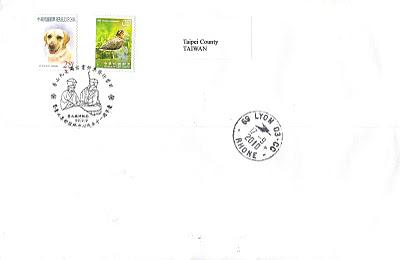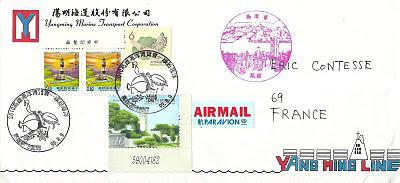Certains philatélistes amateurs de plis postés à des dates symboliques (le 08/09/10 par exemple en attendant le dimanche 10/10/10...) n'ont sans doute pas pensé à une autre date, le 9/9/99, uniquement possible sur l'île de Taïwan !
Comme déjà évoqué sur ce blog, Taïwan utilise à la fois notre calendrier mais aussi le calendrier Minguo qui débute en 1911 (soulèvement de Wuchang) avec 1912 (année de la proclamation de la république de Chine) considérée comme la 1ère année.
Donc l'année 2010 correspond à l'année 99 dans ce calendrier et l'année 2011 sera donc une autre année importante à Taïwan qui commémorera les 100 ans de la république de Chine...
J'ai eu la grande chance de recevoir la superbe lettre recommandée ci-dessous, avec oblitération spéciale du 9/9/99 (différente toutefois du timbre à date "1er jour").
Merci beaucoup Cheng :-)
Many stamps and covers collectors are looking for symbolic dates (eg 08/09/10 recently or next Sunday 10/10/10...) but some may not have thought to another date, 9/9/99 only possible on the island of Taiwan !
As already mentioned on this blog, Taiwan is indeed using both our calendar but also the Minguo calendar beginning in 1911 (Wuchang Uprising) with 1912 (year of the proclamation of the Republic of China), considered as the first year.
So the year 2010 is the year 99 in this calendar and the year 2011 will then be another important year in Taiwan that will commemorate the 100th anniversary of the Republic of China...
I was very lucky to receive the beautiful registered cover below, with a special cancellation of 9/9/99 (but different from the FDC postmark).
Thank you very much Cheng :-)
 Le splendide bloc-feuillet reproduit une peinture intitulée "Les 9 sages du Mont Hsiang", datant de la dynastie Song (de 960 à 1279) par un artiste inconnu, faisant partie des collections du musée du palais national à Taipei.
Le splendide bloc-feuillet reproduit une peinture intitulée "Les 9 sages du Mont Hsiang", datant de la dynastie Song (de 960 à 1279) par un artiste inconnu, faisant partie des collections du musée du palais national à Taipei.Cette peinture raffinée de petite taille, en forme d'éventail, met en scène 9 personnages âgés de plus de 70 ans en train de se distraire, au milieu de pins et de rochers : deux hommes lisent dans un bosquet de bambou (timbre oval à 25 NT$), trois hommes discutent et observent un 4ème homme (avec une fleur sur la tête) qui danse (timbre rond à 25 NT$), un homme assiste à une partie d'échecs entre deux autres hommes, avec une jeune servante à proximité (timbre rond à 5 NT$).
The beautiful souvenir sheet reproduces a painting entitled "Nine Elders of Mt. Hsiang", dating from the Song Dynasty (960-1279) by an unknown artist, from the collections of the National Palace Museum in Taipei.
This small size refined painting, fan-shaped, features nine characters, older than 70, during a party, in a landscape made of pine trees and boulders : two men reading from a scroll in a bamboo grove (oval NT $ 25.00 stamp), three men talking and watching a fourth man (with a flower on his head) dancing (round NT $ 25.00 stamp), a man attending a chess game between two other men, with a young servant standing nearby (round NT $ 5.00 stamp).
 Cheng a complété son affranchissement avec deux timbres courants apposés sur l'autre côté de sa lettre ci-dessus.
Cheng a complété son affranchissement avec deux timbres courants apposés sur l'autre côté de sa lettre ci-dessus.J'ai déjà évoqué sue ce blog le timbre à gauche (2,50 NT$) émis dans la 2ème partie (4 timbres), le 8 mars 2006, d'une série consacrée à des animaux domestiques (chiens et chats), un labrador ici.
L'autre timbre (0,50 NT$) a été émis le 15 janvier 2009 dans la 4ème et dernière partie (4 timbres) d'une autre série courante, débutée en 2007, consacrée à des oiseaux de Taïwan.
Une rhynchée peinte (Rostratula benghalensis) est représentée sur ce timbre. Cet oiseau, qui fréquente les zones humides des plaines tropicales, est caractérisé par un dimorphisme sexuel inversé (la femelle ayant un plumage plus coloré que le mâle)...
Cheng has completed her postage with two definitive stamps affixed to the other side of her letter above.
I've already mentioned on this blog the stamp on the left (NT $ 2.50) issued in the second part (4 stamps), on March 8, 2006, of a series devoted to pets (dogs and cats), a Labrador here.
The other stamp (NT $ 0.50) was issued on January 15, 2009 in the 4th and final part (4 stamps) of an other definitive series, started in 2007, devoted to birds of Taiwan.
A Greater Painted Snipe (Rostratula benghalensis) is featured on this stamp. This bird, living in the tropical plains wetlands, is characterized by a reversed sexual dimorphism (the female is larger and more brightly colored than the male)...
 Restons à Taïwan avec cette autre lettre spéciale ci-dessus, postée le 9 août 99 (2010) de la ville portuaire de Kaohsiung. Merci beaucoup Wei Yi :-)
Restons à Taïwan avec cette autre lettre spéciale ci-dessus, postée le 9 août 99 (2010) de la ville portuaire de Kaohsiung. Merci beaucoup Wei Yi :-)L'oblitération spéciale provient du bureau temporaire de la Chunghwa Post installé à l'exposition sur les océans et les bateaux ("Ocean Expo & Boat Show"), organisée à Kaohsiung du 6 au 9 août 2010. A noter qu'une oblitération différente était proposée au public chaque jour de cette manifestation.
J'ai déjà évoqué sur ce blog les 3 timbres ci-dessus représentant des phares. Le 4ème timbre (6 NT$) fait partie d'une réimpression, le 15 juillet 1999, d'une série courante, émise une 1ère fois en 1995, reproduisant des gravures anciennes montrant des fleurs ou des fruits.
Concernant cette réimpression, les valeurs nominales sont différentes ainsi que la mention "République de Chine" en caractères chinois, écrite cette fois de gauche à droite...
Let's stay in Taiwan with the other special cover above, mailed on August 9, 99 (2010) from the port city of Kaohsiung. Thank you very much Wei Yi :-)
The special postmark comes from the Chunghwa Post's temporary office installed at the Kaohsiung 2010 "Ocean Expo & Boat Show", held from 6 to 9 August 2010. To note that a different cancellation was offered to the public each day of this event.
I've already mentioned on this blog the three stamps above featuring lighthouses. The fourth stamp (NT $ 6.00) is a 2nd print, issued on July 15, 1999, of a definitive series, issued a first time in 1995, reproducing ancient Chinese engravings depicting flowers or fruits.
About this 2nd print, nominal values are different and the words "Republic of China" in Chinese characters, written this time from left to right...

